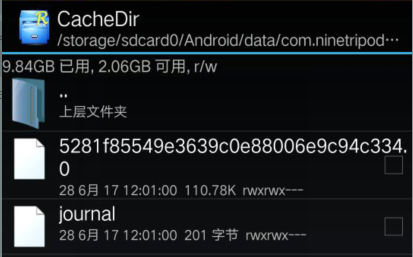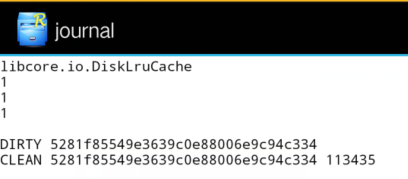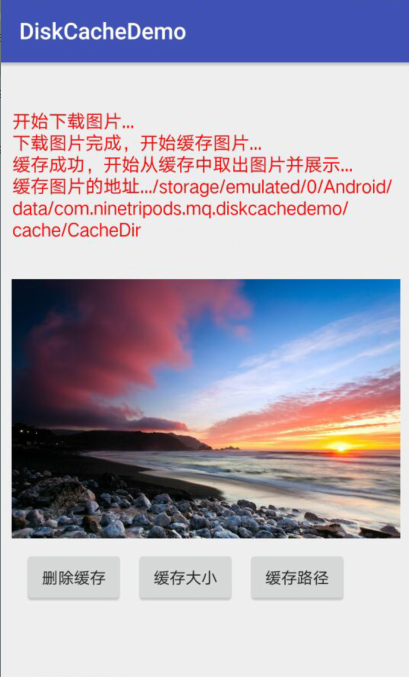本文已同步发表于我的微信公众号,搜索
代码说即可关注,欢迎与我沟通交流。
写在前面
DiskLruCache 不同于LruCache,LruCache是将数据缓存到内存中去,而DiskLruCache是外部缓存,例如可以将网络下载的图片永久的缓存到手机外部存储中去,并可以将缓存数据取出来使用,DiskLruCache不是google官方所写,但是得到了官方推荐,DiskLruCache没有编写到SDK中去,如需使用可直接copy这个类到项目中去。
DiskLruCache地址:
https://android.googlesource.com/platform/libcore/+/android-4.1.1_r1/luni/src/main/java/libcore/io/DiskLruCache.java
或者可以在Jake大神的Github上找到:
https://github.com/JakeWharton/DiskLruCache
DiskLruCache常用方法
| 方法 | 备注 |
|---|---|
| DiskLruCache open(File directory, int appVersion, int valueCount, long maxSize) | 打开一个缓存目录,如果没有则首先创建它,directory:指定数据缓存地址 appVersion:APP版本号,当版本号改变时,缓存数据会被清除 valueCount:同一个key可以对应多少文件 maxSize:最大可以缓存的数据量 |
| Editor edit(String key) | 通过key可以获得一个DiskLruCache.Editor,通过Editor可以得到一个输出流,进而缓存到本地存储上 |
| void flush() | 强制缓冲文件保存到文件系统 |
| Snapshot get(String key) | 通过key值来获得一个Snapshot,如果Snapshot存在,则移动到LRU队列的头部来,通过Snapshot可以得到一个输入流InputStream |
| long size() | 缓存数据的大小,单位是byte |
| boolean remove(String key) | 根据key值来删除对应的数据,如果该数据正在被编辑,则不能删除 |
| void delete() | 关闭缓存并且删除目录下所有的缓存数据,即使有的数据不是由DiskLruCache 缓存到本目录的 |
| void close() | 关闭DiskLruCache,缓存数据会保留在外存中 |
| boolean isClosed() | 判断DiskLruCache是否关闭,返回true表示已关闭 |
| File getDirectory() | 缓存数据的目录 |
如何使用DiskLruCache
1、因为要操作外部存储,所以必须要先加上权限:
<uses-permission android:name="android.permission.WRITE_EXTERNAL_STORAGE" />
另外要从网络下载图片,还要加上权限:
<uses-permission android:name="android.permission.INTERNET" />
2、DiskLruCache是在外部存储上(如SD卡),所以首先判断外部存储是否存在:
/**
* Get a usable cache directory (external if available, internal otherwise).
* external:如:/storage/emulated/0/Android/data/package_name/cache
* internal 如:/data/data/package_name/cache
*
* @param context The context to use
* @param uniqueName A unique directory name to append to the cache dir
* @return The cache dir
*/
public static File getDiskCacheDir(Context context, String uniqueName) {
final String cachePath = Environment.MEDIA_MOUNTED.equals(Environment.getExternalStorageState()) ||!isExternalStorageRemovable()
? context.getExternalCacheDir().getPath()
: context.getCacheDir().getPath();
return new File(cachePath + File.separator + uniqueName);
}
(1)、首先判断外部缓存是否被移除或已存满,如果已存满或者外存储被移除,则缓存目录=context.getCacheDir().getPath(),即存到 /data/data/package_name/cache 这个文件系统目录下;
(2)、反之缓存目录=context.getExternalCacheDir().getPath(),即存到 /storage/emulated/0/Android/data/package_name/cache 这个外部存储目录中,PS:外部存储可以分为两种:一种如上面这种路径 (/storage/emulated/0/Android/data/package_name/cache), 当应用卸载后,存储数据也会被删除,另外一种是永久存储,即使应用被卸载,存储的数据依然存在,存储路径如:/storage/emulated/0/mDiskCache,可以通过Environment.getExternalStorageDirectory().getAbsolutePath() + “/mDiskCache” 来获得路径。
3、根据URL下载一个在线图片并把它写到输出流outputstream中:
/**
* Download a bitmap from a URL and write the content to an output stream.
*
* @param urlString The URL to fetch
* @return true if successful, false otherwise
*/
private boolean downloadUrlToStream(String urlString, OutputStream outputStream) {
HttpURLConnection urlConnection = null;
BufferedOutputStream out = null;
BufferedInputStream in = null;
try {
final URL url = new URL(urlString);
urlConnection = (HttpURLConnection) url.openConnection();
in = new BufferedInputStream(urlConnection.getInputStream(), IO_BUFFER_SIZE);
out = new BufferedOutputStream(outputStream, IO_BUFFER_SIZE);
int b;
while ((b = in.read()) != -1) {
out.write(b);
}
return true;
} catch (Exception e) {
Log.e(TAG, "Error in downloadBitmap - " + e);
} finally {
if (urlConnection != null) {
urlConnection.disconnect();
}
try {
if (out != null) {
out.close();
}
if (in != null) {
in.close();
}
} catch (final IOException e) {
}
}
return false;
}
4、上面已经下载了图片,接着初始化DiskLruCache,并使用DiskLruCache.Editor准备缓存:
private static final int MAX_SIZE = 10 * 1024 * 1024;//10MB
private DiskLruCache diskLruCache;
private void initDiskLruCache() {
if (diskLruCache == null || diskLruCache.isClosed()) {
try {
File cacheDir = CacheUtil.getDiskCacheDir(this, "CacheDir");
if (!cacheDir.exists()) {
cacheDir.mkdirs();
}
//初始化DiskLruCache
diskLruCache = DiskLruCache.open(cacheDir, 1, 1, MAX_SIZE);
} catch (IOException e) {
e.printStackTrace();
}
}
}
下载图片时需要放在异步线程里,这里放在了AsyncTask的doInBackground中:
@Override
protected Boolean doInBackground(Object... params) {
try {
String key = Util.hashKeyForDisk(Util.IMG_URL);
DiskLruCache diskLruCache = (DiskLruCache) params[0];
//得到DiskLruCache.Editor
DiskLruCache.Editor editor = diskLruCache.edit(key);
if (editor != null) {
OutputStream outputStream = editor.newOutputStream(0);
if (downloadUrlToStream(Util.IMG_URL, outputStream)) {
publishProgress("");
//写入缓存
editor.commit();
} else {
//写入失败
editor.abort();
}
}
diskLruCache.flush();
} catch (IOException e) {
e.printStackTrace();
return false;
}
return true;
}
上面代码中有个hashKeyForDisk()方法,其作用是把图片URL经过MD5加密生成唯一的key值,避免了URL中可能含有非法字符问题,hashKeyForDisk()代码如下:
/**
* A hashing method that changes a string (like a URL) into a hash suitable for using as a
* disk filename.
*/
public static String hashKeyForDisk(String key) {
String cacheKey;
try {
final MessageDigest mDigest = MessageDigest.getInstance("MD5");
mDigest.update(key.getBytes());
cacheKey = bytesToHexString(mDigest.digest());
} catch (NoSuchAlgorithmException e) {
cacheKey = String.valueOf(key.hashCode());
}
return cacheKey;
}
private static String bytesToHexString(byte[] bytes) {
// http://stackoverflow.com/questions/332079
StringBuilder sb = new StringBuilder();
for (int i = 0; i < bytes.length; i++) {
String hex = Integer.toHexString(0xFF & bytes[i]);
if (hex.length() == 1) {
sb.append('0');
}
sb.append(hex);
}
return sb.toString();
}
经过上面的代码,我们已经可以看到图片已经缓存到 /storage/emulated/0/Android/data/package_name/cache/CacheDir 这个目录下了:

第一个标识为110.78kb大小的就是我们缓存下来的图片,它的名字正是由图片的URL经过MD5加密得到的,它下面的journal文件是用来记录的,来看里面的内容:

- 第一行:libcore.io.DiskLruCache固定写死
- 第二行:DiskLruCache版本号
- 第三行:APP版本号,由open()方法的参数appVersion传入
- 第四行:同一个key可以对应多少文件,由open()方法的参数valueCount传入,一般为1
- 第五行:空格
- 第六行:以DIRTY开头,后面跟着的是图片的key值,表示准备缓存这张图片,当调用DiskLruCache的edit()时就会生成这行记录
- 第七行: 以CLEAN开头,后面跟着的是图片的Key值和大小,当调用editor.commit()时会生成这条记录,表示缓存成功;如果调用editor.abort()表示缓存失败,则会生成REMOVE开头的表示删除这条数据。
5、通过diskLruCache.get(key)得到DiskLruCache.Snapshot,key是经过MD5加密后那个唯一的key,接着使用Snapshot.getInputStream()可以得到输入流InputStream ,进而得到缓存图片:
private Bitmap getCache() {
try {
String key = Util.hashKeyForDisk(Util.IMG_URL);
DiskLruCache.Snapshot snapshot = diskLruCache.get(key);
if (snapshot != null) {
InputStream in = snapshot.getInputStream(0);
return BitmapFactory.decodeStream(in);
}
} catch (IOException e) {
e.printStackTrace();
}
return null;
}
Bitmap bitmap = getCache();
if (bitmap != null) {
iv_img.setImageBitmap(bitmap);
}
效果图:

完整Demo地址:
http://download.csdn.net/detail/u013700502/9883037






















 1943
1943











 被折叠的 条评论
为什么被折叠?
被折叠的 条评论
为什么被折叠?










